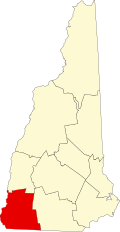Parsons Studio and Casino | |
 | |
| Location | Parsons Rd., Dublin, New Hampshire |
|---|---|
| Coordinates | 42°53′7″N72°3′7″W / 42.88528°N 72.05194°W |
| Area | 1.4 acres (0.57 ha) |
| Built | 1903 |
| Architect | A.R. James |
| Architectural style | Shingle Style |
| MPS | Dublin MRA |
| NRHP reference No. | 83004058 [1] |
| Added to NRHP | December 18, 1983 |
The Parsons Studio and Casino is a historic house on Parsons Road in Dublin, New Hampshire. Built about 1903 as an entertainment space and enlarged several times as a residence and art studio, it is a good example of Shingle style architecture from Dublin's heyday as a summer resort and artists' colony. The house was listed on the National Register of Historic Places in 1983. [1]


